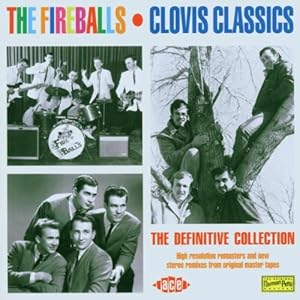
I’ve stopped going to the library these days. Well, that’s not true. I still go to the neighbourhood library to borrow books. I can’t get CDs there because they only let you keep them for a week, and I can’t go every week. It’s the neighbourhood library, just not my neighbourhood.
But I haven’t gone to the downtown library. That’s where all the CDs are. I’ve borrowed books there too but it’s tough because not more than 25% of the collection (I’m estimating) is English. So it’s just music mostly that I go for. And it’s gotten out of control. So I put it to rest for a while.
That’s neither here nor there. Let’s talk about The Fireballs. I’d never heard of them until Bottle Of Wine hit the top 40 in 1968. I thought it was pretty cool, a song about getting drunk. Later I discovered Sugar Shack, which didn’t even sound like the same group, and then even later I learned that in its original identity The Fireballs were an instrumental group. So we have the instrumental group of Torquay and Bulldog, the pop vocal group of Sugar Shack, and the faux hippie group of Bottle Of Wine. The fact they never quite figured out who they were didn’t help their legacy much. Some remember them only for the supposedly subpar instrumental support they provide on posthumously released Buddy Holly singles. Whatever.
This is an incredible collection that captures all the group’s various personas, and includes, amazingly, all of their top 100 hits (they had 11) . It’s called The Definitive Collection, and it’s subtitled Clovis Classics. Or perhaps it’s called Clovis Classics, and subtitled Definitive Collection. Clovis is where the tracks were recorded, same studio that Buddy Holly used.
• Torquay – From the ting ting ting on the cymbal to the slinky guitar, this song set the style that was to mark the group’s instrumental oeuvre. Their first hit, from the fall / winter of 1959. I don’t know what the word means.
• Long Long Ponytail – The intro is reminiscent of Move It by Cliff Richard & The Shadows. I don’t know who the vocalist is on this, but it’s easy to understand why they specialized in instrumentals.
• Bulldog – A boss instrumental from the winter of 1960.
• I Don’t Know – Neither do I. Another vocal track.
• Vaquero (Cowboy) – Vaguely in the style of Ghost Riders In The Sky. From the fall of 1960.
• Cry Baby – Not the Garnet Mimms hit (the one covered by Janis Joplin). Jimmy Gilmer apparently hadn’t appeared yet, but the group was heading into his pop territory on this.
• Rik-A-Tik
• Yacky Doo
• Sugar Shack – What sounds like a clavinet shows up here, and what sounds like a tin whistle, and it changes the sound of the group rather dramatically. And then there’s Jimmy Gilmer, whose voice threw the group into an entirely new dimension. And then there’s the expresso [sic] coffee. This song joins the ranks of songs about wonderful hangouts, but it wasn’t just the place, it was the girl working there, and of course they married and they are living happily. This was number 1 in the fall of 1963.
• Quite A Party – Back to the instrumentals. From the summer of 1961.
• Gunshot – Junior Walker did Shotgun; this is Gunshot.
• Daisy Petal Pickin’ – The follow-up to Sugar Shack used many of the same musical flourishes, but this tale of love’s uncertainty only reached number 15. That was early in 1964, just as The Beatles were making their impact.
• Foot Patter
• Dumbo – Maybe this is about the elephant but I can’t prove it because there aren’t any words.
• Ain’t Gonna Tell Anybody – This was the last attempt to milk the success of Sugar Shack. It only reached number 53, and that was in the spring of 1964. Not hard to understand why; it’s just a bit too cute.
• Fireball – Maybe this was meant to be their signature tune. It has a vaguely exotic air about it.
• Say I Am (What I Am) - A hit for Tommy James & The Shondells.
• Sweet Talk – Strings on this one, and whistling that gives it the air of something by Ennio Morricone. Sort of.
• Hungry, Hungry, Hungry – Maybe this was inspired by Yummy Yummy Yummy. I hope not.
• Mexican Fun – I guess it’s that mariachi trumpet that makes this Mexican.
• Good Morning Shame – Boy I really tied one on, seems to be the message, but the delivery is so mild that it’s not all that convincing.
• Find Me A Golden Street
• Ain’t That Rain – From their latter-day period. This aims at a kind of mellow, and it’s not bad.
• Clink Clink Classic
• Bottle Of Wine – Their one hit that kicks butt. This is nothing more than a paean to alcoholism, written by Tom Paxton. It’s the Fireballs that I remember. From the winter of 1968.
• Come On Home – Here’s where they are the purveyors of faceless pop.
• Goin’ Away (The One Who Lives Inside Of Me)- A hippie era song about finding oneself. I’ll send for you, he says, when I find out who the heck I am.
• Lucille – A lame rendition of the Little Richard song.
• Come On React – The follow-up to Bottle Of Wine didn’t do nearly as well. Full of hippie jargon (“you’ve got your bag and I’ve got mine”). From the winter of ’68 / ’69.
• Long Green – A song about money. Their swan song. A minor hit in the winter of 1969. Also done by The Kingsmen.
But I haven’t gone to the downtown library. That’s where all the CDs are. I’ve borrowed books there too but it’s tough because not more than 25% of the collection (I’m estimating) is English. So it’s just music mostly that I go for. And it’s gotten out of control. So I put it to rest for a while.
That’s neither here nor there. Let’s talk about The Fireballs. I’d never heard of them until Bottle Of Wine hit the top 40 in 1968. I thought it was pretty cool, a song about getting drunk. Later I discovered Sugar Shack, which didn’t even sound like the same group, and then even later I learned that in its original identity The Fireballs were an instrumental group. So we have the instrumental group of Torquay and Bulldog, the pop vocal group of Sugar Shack, and the faux hippie group of Bottle Of Wine. The fact they never quite figured out who they were didn’t help their legacy much. Some remember them only for the supposedly subpar instrumental support they provide on posthumously released Buddy Holly singles. Whatever.
This is an incredible collection that captures all the group’s various personas, and includes, amazingly, all of their top 100 hits (they had 11) . It’s called The Definitive Collection, and it’s subtitled Clovis Classics. Or perhaps it’s called Clovis Classics, and subtitled Definitive Collection. Clovis is where the tracks were recorded, same studio that Buddy Holly used.
The Fireballs:
• Torquay – From the ting ting ting on the cymbal to the slinky guitar, this song set the style that was to mark the group’s instrumental oeuvre. Their first hit, from the fall / winter of 1959. I don’t know what the word means.
• Long Long Ponytail – The intro is reminiscent of Move It by Cliff Richard & The Shadows. I don’t know who the vocalist is on this, but it’s easy to understand why they specialized in instrumentals.
• Bulldog – A boss instrumental from the winter of 1960.
• I Don’t Know – Neither do I. Another vocal track.
• Vaquero (Cowboy) – Vaguely in the style of Ghost Riders In The Sky. From the fall of 1960.
• Cry Baby – Not the Garnet Mimms hit (the one covered by Janis Joplin). Jimmy Gilmer apparently hadn’t appeared yet, but the group was heading into his pop territory on this.
• Rik-A-Tik
• Yacky Doo
• Sugar Shack – What sounds like a clavinet shows up here, and what sounds like a tin whistle, and it changes the sound of the group rather dramatically. And then there’s Jimmy Gilmer, whose voice threw the group into an entirely new dimension. And then there’s the expresso [sic] coffee. This song joins the ranks of songs about wonderful hangouts, but it wasn’t just the place, it was the girl working there, and of course they married and they are living happily. This was number 1 in the fall of 1963.
• Quite A Party – Back to the instrumentals. From the summer of 1961.
• Gunshot – Junior Walker did Shotgun; this is Gunshot.
• Daisy Petal Pickin’ – The follow-up to Sugar Shack used many of the same musical flourishes, but this tale of love’s uncertainty only reached number 15. That was early in 1964, just as The Beatles were making their impact.
• Foot Patter
• Dumbo – Maybe this is about the elephant but I can’t prove it because there aren’t any words.
• Ain’t Gonna Tell Anybody – This was the last attempt to milk the success of Sugar Shack. It only reached number 53, and that was in the spring of 1964. Not hard to understand why; it’s just a bit too cute.
• Fireball – Maybe this was meant to be their signature tune. It has a vaguely exotic air about it.
• Say I Am (What I Am) - A hit for Tommy James & The Shondells.
• Sweet Talk – Strings on this one, and whistling that gives it the air of something by Ennio Morricone. Sort of.
• Hungry, Hungry, Hungry – Maybe this was inspired by Yummy Yummy Yummy. I hope not.
• Mexican Fun – I guess it’s that mariachi trumpet that makes this Mexican.
• Good Morning Shame – Boy I really tied one on, seems to be the message, but the delivery is so mild that it’s not all that convincing.
• Find Me A Golden Street
• Ain’t That Rain – From their latter-day period. This aims at a kind of mellow, and it’s not bad.
• Clink Clink Classic
• Bottle Of Wine – Their one hit that kicks butt. This is nothing more than a paean to alcoholism, written by Tom Paxton. It’s the Fireballs that I remember. From the winter of 1968.
• Come On Home – Here’s where they are the purveyors of faceless pop.
• Goin’ Away (The One Who Lives Inside Of Me)- A hippie era song about finding oneself. I’ll send for you, he says, when I find out who the heck I am.
• Lucille – A lame rendition of the Little Richard song.
• Come On React – The follow-up to Bottle Of Wine didn’t do nearly as well. Full of hippie jargon (“you’ve got your bag and I’ve got mine”). From the winter of ’68 / ’69.
• Long Green – A song about money. Their swan song. A minor hit in the winter of 1969. Also done by The Kingsmen.


No comments:
Post a Comment